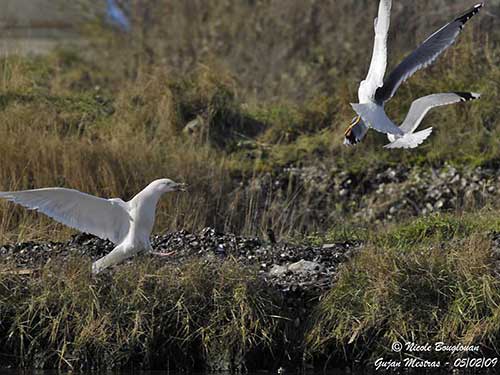Fr: Goéland bourgmestre
Ang: Glaucous Gull
All: Eismöwe
Esp: Gavión Hiperbóreo
Ita: Gabbiano glauco
Nd: Grote Burgemeester
Sd: Vittrut
Photographers:
John Anderson
John Anderson Photo Galleries
Didier Buysse
Vision d’Oiseaux
Tom Grey
Tom Grey's Bird Pictures
Otto Plantema
Trips around the world
Ingo Waschkies
Bird Photography
Nicole Bouglouan
PHOTOGRAPHIC RAMBLE
Text by Nicole Bouglouan
Sources:
HANDBOOK OF THE BIRDS OF THE WORLD Vol 3 by Josep del Hoyo-Andrew Elliott-Jordi Sargatal - Lynx Edicions - ISBN : 8487334202
THE HANDBOOK OF BIRD IDENTIFICATION FOR EUROPE AND THE WESTERN PALEARCTIC by Mark Beaman, Steve Madge - C. Helm - ISBN: 0713639601
THE COMPLETE BOOK OF BRITISH BIRDS – Written by “Royal Society for the Protection of Birds” experts - Préface de Magnus Magnusson - Michael Cady- Rob Hume Editors - ISBN: 0749509112
All About Birds (Cornell Lab of Ornithology)
Bird Web (Seattle Audubon Society)
Alaska Seabird Information Series
What Bird-The ultimate Bird Guide (Mitchell Waite)
Wikipedia, the free encyclopaedia
Glaucous Gull
Larus hyperboreus
Charadriiformes Order – Laridae Family
INTRODUCTION:
The Glaucous Gull is a common species throughout Arctic regions. It is a predator during summer, and is still dominant in winter among the large mixed flocks. It is very opportunistic and can take advantage of any occasion to feed, and it “pirates” other birds to steal their prey in flight.
This large Laridae has circumpolar range, and it is the only common large gull as far north.
DESCRIPTION OF THE BIRD:
Biometrics:
Length: 64-77 cm
Wingspan: 132-142 cm
Weight: 1070-1820 g
The Glaucous Gull is a large Laridae fairly similar in size to the Great Black-backed Gull. It is a stocky bird with long, strong bill and relatively short wings.
Mantel and wings are pale grey. The flight feathers have white tips. The underparts are white with some indistinct streaks on the upper breast. The tail is white.
The head is white. The yellow bill has red gonydeal spot. The eyes are pale yellow, surrounded by yellow-orange eyering. Legs and webbed feet are pinkish.
The female has similar plumage, but she is slightly smaller than male.
The adult in winter is slightly streaked and mottled brown on head and nape.
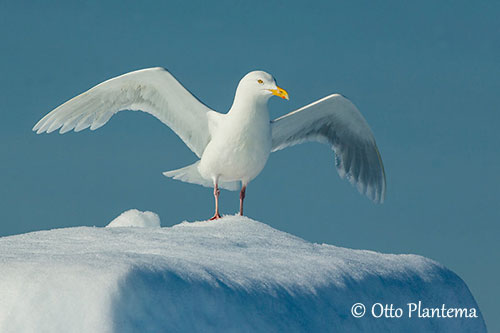
The juvenile show scaled pattern above, with variable amount of pale buff-edged feathers. The wing tips can be whitish to pale brown. The underparts are pale brown. The bill is pink with black tip. The eyes are dark.
The second winter has pale eyes, and the extreme tip of the bill is black. It has more uniform grey-brown plumage, with less streaked pattern on mantel, wings and tail.
The third winter is very similar to the adult, but it still shows some brown areas on wings and tail. There is a black, not red, gonydeal spot on lower mandible.
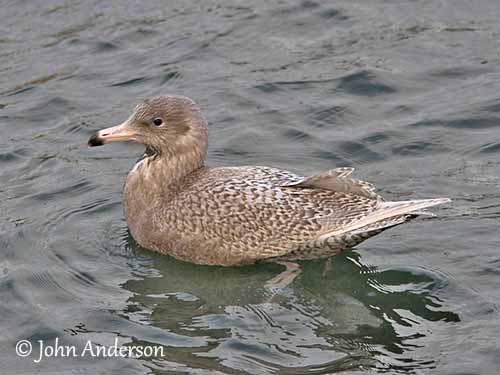
1st winter
Scotland
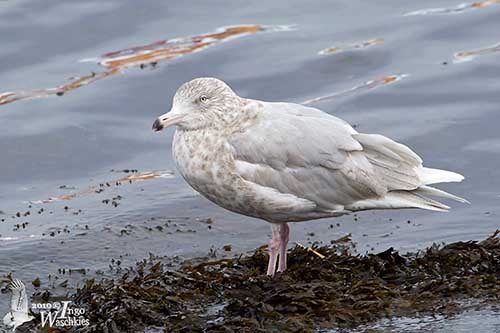
2d winter
Finland - Norway
SUBSPECIES AND RANGE:
The Glaucous Gull has four recognized subspecies. They differ by the size and the tone of grey on mantle. There are several individual variations.
L.h. hyperboreus (described above) is found on Jan Mayen and Svalbard, E to Taymyr Peninsula.
L.h. pallidissimus occurs on Taymyr Peninsula E to Bering Sea, including Pribilof Islands.
L.h. barrovianus occurs on the coasts of W Alaska to W Canada, in NW Mackenzie region. This race is larger and darker.
L.h. leuceretes is also found in Mackenzie region and N Canadian archipelago to Greenland and Iceland
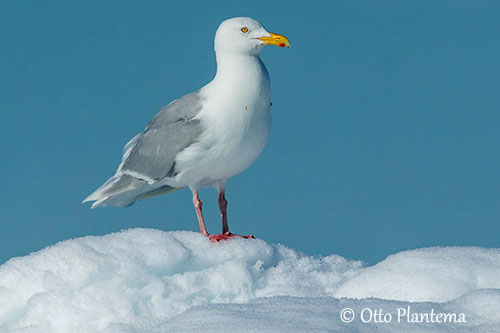
L.h. hyperboreus
Svalbard / Spitzberg
The Glaucous Gull is common around the Arctic. It breeds in Iceland, Greenland, Canada, N Russia, N Europe and in Asia. It winters S to N and WC Europe, in N Pacific from E Asia to Japan, and from Aleutians to California, and in NE North America too.
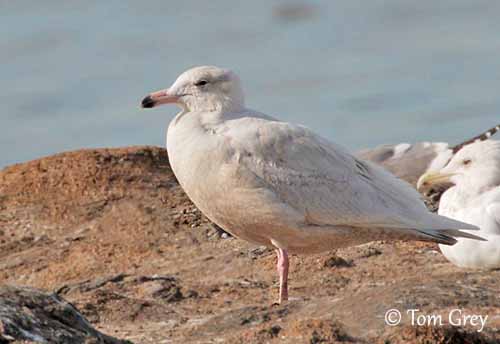
1st winter
California
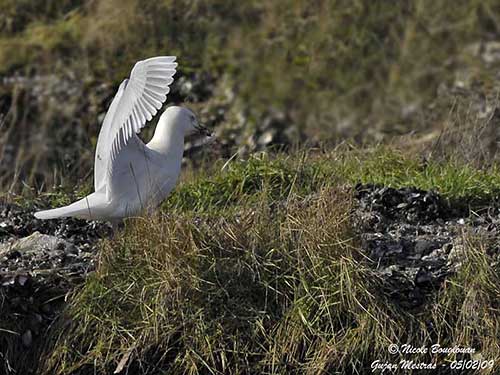
HABITAT:
The Glaucous Gull is mainly coastal. It frequents estuaries, bays, reservoirs, garbage dumps and harbors. However, it flies sometimes well offshore.
It breeds on cliffs, islands, beaches and rocky coasts in Arctic and subarctic regions.
During winter, some birds may be found on large inland lakes.
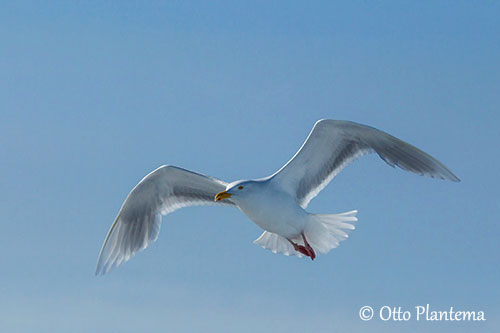
CALLS AND SONGS: SOUNDS BY XENO-CANTO
The Glaucous Gull gives hoarse calls, sometimes very deep sounds. It also gives short yapping and high-pitched wailing notes. It utters series of hard croaking and screaming. It is quieter during winter and can be very silent when satiated.
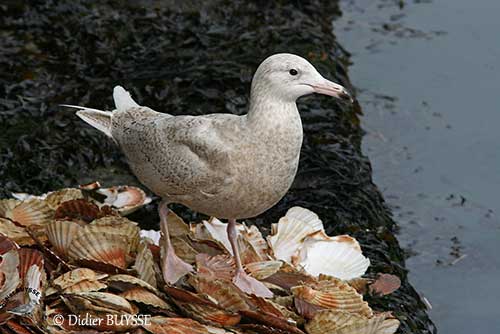
BEHAVIOUR IN THE WILD:
The Glaucous Gull feed on wide variety of preys including fish, rodents, eggs and chicks of ducks, alcids and waders, marine invertebrates, molluscs, crustaceans, carrion and various debris. It may eat the faeces of marine mammals and also feed on their carcasses. It follows the trawlers for offal.
The undigested food parts are discarded as pellets often visible around the nest.
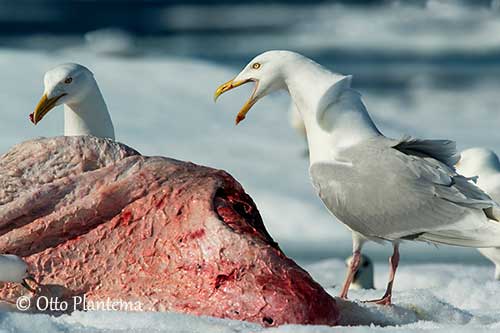
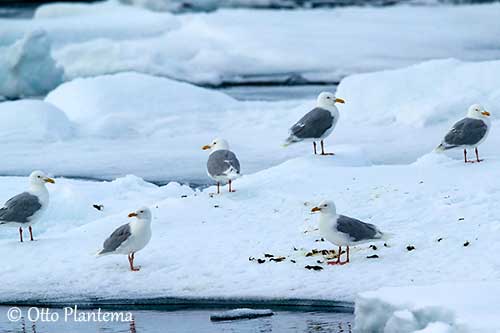
It forages by walking on the ground, in flight and while flying low from the surface and seizes preys with the bill. It may catch small birds in flight. It “pirates” other seabirds such as Laridae and jaegers, when they are regurgitating the food, but it also steals their preys.
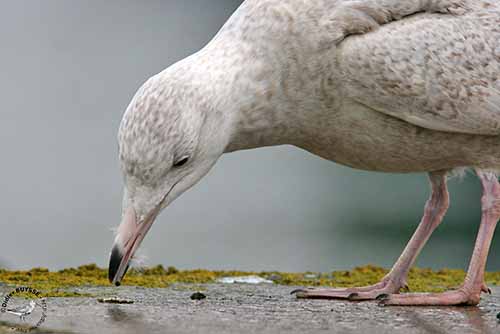
It is a predator during summer, but it is still dominant in winter, among the large mixed flocks. Outside the breeding season, it is gregarious and forms small groups or larger flocks including 10 to thousands birds.
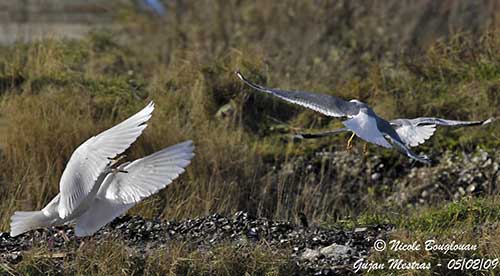
The Glaucous Gull breeds in colonies or as isolated pairs.
On the breeding grounds, the pairs defend the territory and strengthen the pair-bond through various calls or wailing notes while moving the head. The “long-call” is the typical display for most gulls. The bird raises the head and gradually lowers it while uttering the series of long notes. This display is followed by series of “head-tosses” when the gull flings the head up over its back while giving wailing calls.
Once the pair is formed, courtship feeding is frequent, with displays and calling.
The Glaucous Gull is partially migratory. The W Palearctic populations often remain on their breeding grounds in winter. But sometimes, the birds move far south. This species has been recorded in SW France, Portugal, Azores, Madeira, Canary Islands and Morocco.
Like all gulls, the Glaucous Gull is a good flier, performing agile and powerful flight. It glides on ascendant thermals and flies with steady wingbeats.
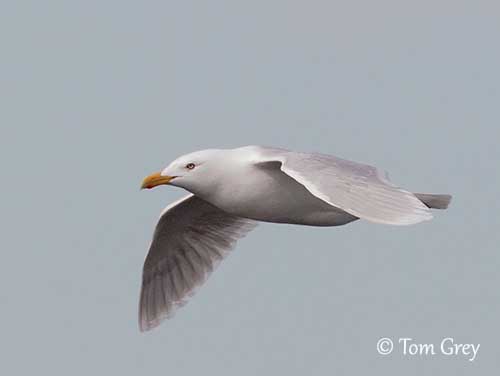
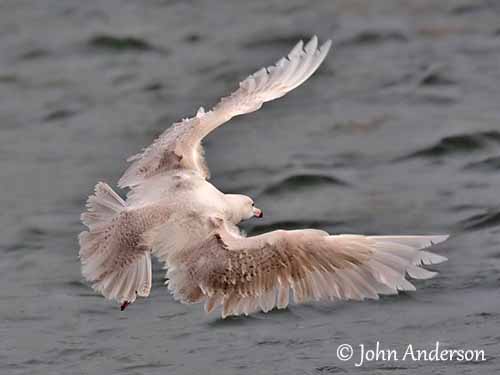
REPRODUCTION OF THIS SPECIES:
The Glaucous Gull nests along the Arctic coasts, as solitary pairs or in small colonies or groups with other seabirds. The egg-laying occurs in May-June, depending on the ice.
The nest is built on cliff edge, on rock or on sloping ground, usually inside a rocky depression, sometimes on snow or even ice.
Both adults build the nest with seaweeds and grass, with a lining of softer grasses.
The female lays 2-3 brownish eggs with irregular, darker brown markings. The incubation lasts 27-30 days. At hatching, the chicks have pale, greyish down with dark markings. They are fed by both parents but usually, they leave the nest a few days after hatching and remain in the surrounding. They can fly at 45-50 days of age and are independent in early September. They are mature at 4 years old.
The adults strongly defend both nest and chicks, attacking even humans by aerial dives, and strikes with their feet.
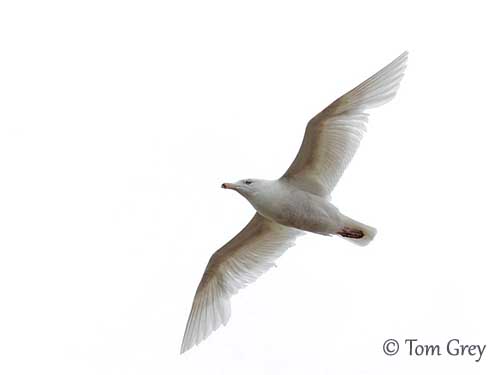
PROTECTION / THREATS / STATUS:
The Glaucous Gull has still its original habitat and currently, it is not often disturbed by human activities. However, it is sometimes displaced by the Herring Gull in some areas. Like other seabirds, it is threatened by fishing nets at sea. In Alaska, hunting and egg collection are still active.
The global population is suspected to be stable and even slightly increasing. It is estimated to number 340 000/2 400 000 individuals (Wetlands International 2006).
The Glaucous Gull is currently evaluated as Least Concern.
